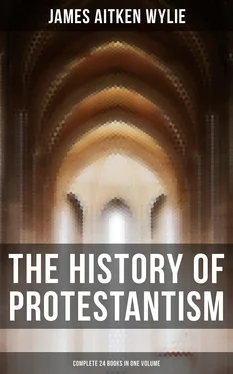This great empire was served by numerous armies and powerful fleets. Her soldiers, drawn from every nation, and excellently disciplined, were brave, hardy, familiar with danger, and inured to every climate from the tropics to the arctic regions. They were led by commanders of consummate ability, and the flag under which they marched had conquered on a hundred battlefields. When the master of all these provinces, armies and fleets, added the imperial diadem, as Charles V. did, to all his other dignities, his glory was perfected. We may adapt to the Spanish monarch the bold image under which the prophet presented the greatness of the Assyrian power. "The" Spaniard "was a cedar in" Europe "with fair branches, and with a shadowing shroud, and of an high stature; and his top was among the thick boughs. The waters made him great, the deep set him up on high with her rivers running round about his plants, and sent out her little rivers unto all the trees of the field. Therefore his height was exalted above all the trees of the field, and his boughs were multiplied, and his branches became long because of the multitude of waters, when he shot forth." (Ezekiel 31:3-5)
The monarch of Spain, though master of so much, was laying schemes for extending the limits of his already overgrown dominions, and making himself absolute and universal lord. Since the noon of the Roman power, the liberties of the world had at no time been in so great peril as now. The shadow of a universal despotism was persistently projecting itself farther and yet farther upon the kingdoms and peoples of Western Europe. There was no principle known to the men of that age that seemed capable of doing battle with this colossus, and staying its advance. This despotism, into whose hands as it seemed the nations of Christendom had been delivered, claimed a Divine right, and, as such, was upheld by the spiritual forces of priestcraft, and the material aids of fleets and legions. Liberty was retreating before it. Literature and art had become its allies, and were weaving chains for the men whom they had promised to emancipate. As Liberty looked around, she could see no arm on which to lean, no champion to do battle for her. Unless Protestantism had arrived at that crisis, a universal despotism would have covered Europe, and Liberty banished from the earth must have returned to her native skies. "Dr. Martin Luther, a monk from the county of Mansfeld... by his heroism alone, imparted to the half of Europe a new soul; created an opposition which became the safeguard of freedom."
CHAPTER 3
THE PAPACY, OR CHRISTENDOM UNDER THE TIARA
Table of Contents
Complex Constitution of the Papacy – Temporal Sovereignty limited to Papal States – Pontifical Supremacy covers all Christendom – Governmental Machinery – Legate-a-latere – Interdict – The Concordat – Concordat with Austria – The Papacy in Piedmont – Indulgences – The Confessional – The Papacy Absolute in Temporals as in Spirituals – Enormous Strength
WE now ascend to the summit of the European edifice as constituted at the beginning of the sixteenth century. There was a higher monarch in the world than the emperor, and a more powerful kingdom in Christendom than the Empire. That monarch was the Pope – that Empire, the Papacy.
Any view of Christendom that fails to take note of the relations of the Papacy to its several kingdoms, overlooks the prominent characteristic of Europe as it existed when the great struggle for religion and liberty was begun. The relation of the Papacy to the other kingdoms of Christendom was, in a word, that of dominancy. It was their chief, their ruler. It taught them to see in the Seven Hills, and the power seated thereon, the bond of their union, the fountain of their legislation, and the throne of their government. It thus knit all the kingdoms of Europe into one great confederacy or monarchy. They lived and breathed in the Papacy. Their fleets and armies, their constitutions and laws, existed more for it than for themselves. They were employed to advance the policy and uphold the power of the sovereigns who sat in the Papal chair.
In the one Pontifical government there were rolled up in reality two governments, one within the other. The smaller of these covered the area of the Papal States; while the larger, spurning these narrow limits, embraced the whole of Christendom, making of its thrones and nations but one monarchy, one theocratic kingdom, over which was stretched the scepter of an absolute jurisdiction.
In order to see how this came to pass, we must briefly enumerate the various expedients by which the Papacy contrived to exercise jurisdiction outside its own special territory, and by which it became the temporal not less than the spiritual head of Christendom – the real ruler of the kingdoms of medieval Europe. How a monarchy, professedly spiritual, should exercise temporal dominion, and especially how it should make its temporal dominion co-extensive with Christendom, is not apparent at first sight. Nevertheless, history attests the fact that it did so make it. One main expedient by which the Papacy wielded temporal power and compassed political ends in other kingdoms was the office of "legate-a-latere." The term signifies an ambassador from the Pope's side. The legate-a- latere was, in fact, the alter ego of the Pope, whose person he represented, and with whose power he was clothed. He was sent into all countries, not to mediate but to govern; his functions being analogous to those of the deputies or rulers whom the pagan masters of the world were wont to send from Rome to govern the subject provinces of the Empire.
In the prosecution of his mission the legate-a-latere made it his first business in the particular country into which he entered to set up his court, and to try causes and pronounce judgment in the Pope's name. Neither the authority of the sovereign nor the law of the land was acknowledged in the court of the legate; all causes were determined by the canon law of Rome. A vast multitude of cases, and these by no means spiritual, did the legate contrive to bring under his jurisdiction. He claimed to decide all questions of divorce. These decisions involved, of course, civil issues, such as the succession to landed estates, the ownership of other forms of wealth, and in some instances the right to the throne. All questions touching the lands and estates of the convents, monasteries, and abbeys were determined by the legate. This gave him the direct control of one-half the landed property of most of the kingdoms of Europe. He could impose taxes, and did levy a penny upon every house in France and England. He had power, moreover, to impose extraordinary levies for special objects of the Church upon both clergy and laity. He made himself the arbiter of peace and war. He meddled in all the affairs of princes, conducted perpetual intrigues, fomented endless quarrels, and sustained himself umpire in all controversies. If any one felt himself aggrieved by the judgment of the legate, he could have no redress from the courts of the country, nor even from the sovereign. He must go in person to Rome. Thus did the Pope, through his legate-a-latere, manage to make himself the grand justiciary of the kingdom.
The vast jurisdiction of the legate-a-latere was supported and enforced by the "interdict." The interdict was to the legate instead of an army. The blow it dealt was more rapid, and the subjugation it effected on those on whom it fell was more complete, than any that could have been achieved by any number of armed men. When a monarch proved obdurate, the legate unsheathed this sword against him. The clergy throughout the length and breadth of his kingdom instantly desisted from the celebration of the ordinances of religion. All the subjects were made partners with the sovereign in this ghostly but dreadful infliction. In an age when there was no salvation but through the priesthood, and no grace but through the channel of the Sacraments, the terrors of interdict were irresistible. All the signs of malediction everywhere visible throughout the land on which this terrible chastisement had been laid, struck the imagination with all the greater force that they were viewed as the symbols of a doom which did not terminate on earth, but which extended into the other world. The interdict in those ages never failed to gain its end, for the people, punished for the fault, real or supposed, of their sovereign, broke out into murmurs, sometimes into rebellion, and the unhappy prince found in the long run that he must either face insurrection or make his peace with the Church. It was thus the shadow of power only which was left the king; the substance of sovereignty filched from him was carried to Rome and vested in the chair of the Pope.
Читать дальше












